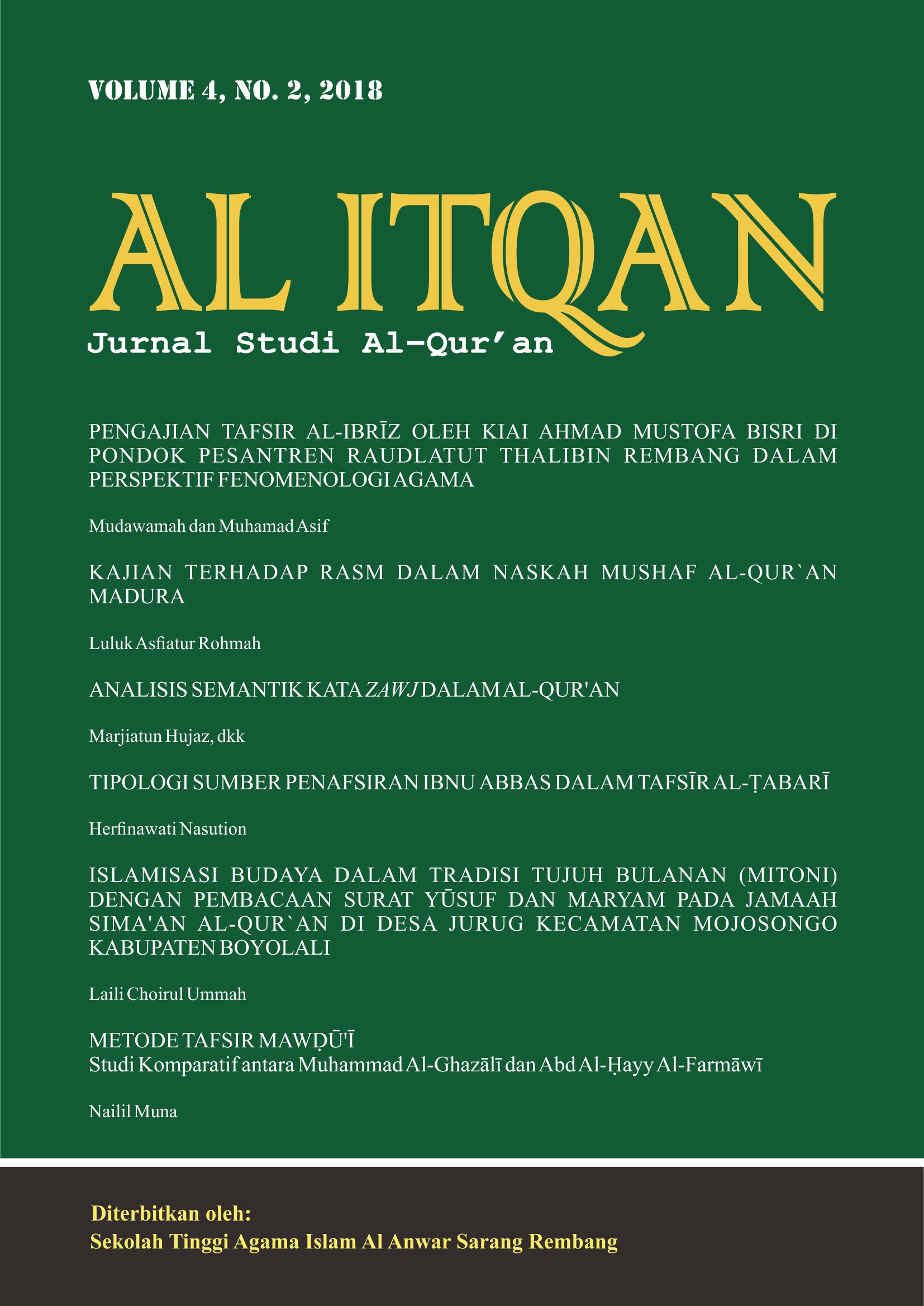ANALISIS SEMANTIK KATA ZAWJ DALAM AL-QUR’AN
DOI:
https://doi.org/10.47454/itqan.v4i2.684Abstract
This study aims to examines the meaning of zawj in al-Qur'an. This research is a qualitative research using descriptive-analysis method. The meaning of zawj in the Qur'an is very vareative. In the Koran with various derivations, the word zawj is 21 derivations contained in 72 verses of 43 surahs and is mentioned in 81 times. The researcher used the semantic analysis of al-Qur'an which was initiated by Toshihiko Izutsu who tried to address the world view of Qu'ran (weltanschauung) through semantic analysis of the vocabulary and key terms in the Qur’an. This research concludes that the basic meaning of the word zawj is something that is not singular or something that has an equivalent. Zawj can be interpreted as: a husband in the surah (al-Mujādalah [58]: 1;wife in the surah (al-Baqarah [2]: 35; a partner, namely Allah created all beings in pairs (az-Dzariyat [51]: 49;animals are male and female pairs (al-An'ām [6]: 143), plants (al-Syu'arā [367]: 7); and groups (al-Wāqi'ah [56]: 7. In the pre- Qur'anic, the word zawj is defined as a rug. In the Qur'anic period it is divided into two, namely Mecca and Medina. The Mecca period has a close meaning with the sign of the greatness of Allah and the pleasure that Allah gives. The Medina period contains the laws of separation. In the post-Qur'anic period, the word zawj describes gender equality, that men and women are the same components without being differentiated, so that there is a harmonious life in pairs.
Downloads
References
Al-Amirī, Labīb bin Rabi'ah. Diwān Labīb Bin Rabiah Al-Amirī, Mesir: Dar al-Ma’rifah, 2004.
Al-Askarī, Abū Hilāl. Mu’jam Al-Furuq Al-Lughawiyah (Damaskus: Mu’assasah al-Nashr al-Islāmiy, 2000)
Al-Ṭabarī, Muhammad bin Jarir, Jami’ Al-Bayān fī Ta’wil Ay Al-Qur’an. ed. Ahmad Muhammad Syakir. Beirut: Mu’assasah al-Risālah, 2000.
Al-Zamaḥsharī, Mahmud bin Umar, Tafsīr Al-Kashshāf. Beirut: Dar Al-Fikr, 1993.
Almirzanah, Syafaatun. Pemikiran Hermeneutika Dalam Tradisi Islam: Reader. Yogyakarta: Lembaga Penelitian, Universitas Islam Negeri Sunan Kalijaga, 2011.
Anwar, Etin. Jati Diri Perempuan Dalam Islam. Bandung: Mizan Pustaka, 2017.
Anwar, Rosihan. Samudra Al-Qur’an. Bandung: Pustaka Setia, 2001.
Asy’ari, Hasyim, “Keistimewaan Bahasa Arab Sebagai Bahasa Al-Qur’an”, Nidhomul Haq: Jurnal Manajemen Pendidikan Islam, Vol.1, No.1 (2016).
Bunyamin, Bachrum dan Salad, Hamday. Syair-Syair Arab Pra Islam: Al-Muallaqāt. Yogyakarta: Gading Pustaka, 2017.
Ibrahim, Musthafa. dkk. Al-Mu’jam Al-Wasīṭ. Istambul: Al-Maktabah Al-Islamiyyah, 1999.
Fachrudin, Aziz Anwar. Pengantar Sejarah Dan Mazhab Linguistik Arab. Sidoarjo: CV. Lisan Arabic, 2017.
Faris, Ahmad bin. Mu’jam Maqayis Al-Lughah, ed. Abdus Salam Muhammad Harun. Beirut: Dar Al-Fikr, 1979.
Ghofur, Saiful Amin. Mozaik Mufasir Al-Qur’an Dari Klasik Hingga Kontemporer. Yogyakarta: Kaukaba, 2013.
Gusmian, Islah. Khazanah Tafsir Indonesia. Jakarta: Teraju, 2003.
Ismail, Ecep. ‘Analisis Semantik Pada Kata Ahzāb Dan Derivasinya Dalam Al-Quran’. Al-Bayan: Jurnal Studi Ilmu Al-Qur’an Dan Tafsir, vol. 1. no. 2(2016).
Izutsu, Toshihiko, Relasi Tuhan Dan Manusia Pendekatan Semantik Terhadap Al-Qur’an, Terj, Agus Fahri Husein Dkk. Yogyakarta: Tiara Wacana, 2003.
Luthfiana, Nur Umi, and Nur Huda. "ANALISIS MAKNA KHAUF DALAM AL-QURAN: Pendekatan Semantik Toshihiko Izutsu." AL ITQAN: Jurnal Studi Al-Qur'an 3, no. 2 (2017): 95-118.
Kathīr, Muhammad bin Umar bin, Tafsīr Al-Qur’an al-’Aẓīm. Beirut: Dar Al-Tayyibah, 1999.
Mahsun, M.S, Metode Penelitian Bahasa Metode Penelitian Bahasa: Tahapan Strategi Metode Dan Tekniknya. Jakarta: Raja Grafindo Persada, 2014.
Manzur, Muhammad bin Mukrim bin, Lisān Al-’Arb. Beirut: Dar Shadir, tth.
Matson, Ingrid. Ulumul Qur’an Zaman Kita. Jakarta: Zaman, 2013.
Moleong, Lexy J. Metode Penelitian Kualitatif. Bandung: Remaja Rosdakarya, 2014.
Mujahid, Ahmad. ‘Makna Sinkronik-Diakronik Kata ‘Usr Dan Yusr Dalam Surat Al-Insyirāh’, Relegia Jurnal Ilmu-Ilmu Keislaman, vol. 22, no.1 (2019),
Shihab, M. Quraish. Tafsir Al-Misbah : Pesan, Kesan Dan Keserasian Al-Qur’an. Jakarta: Lentera Hati, 2002.
Subhan, Zaitunah. Al-Qur’an Dan Perempuan : Menuju Kesetaraan Gender Dalam Penafsiran. Jakarta: Kencana Prenada Media Group, 2015.
Syukri, Ahmad. Metodologi Tafsir Al-Qur’an Kontemporer Dalam Pemikiran Fazlur Rahman. Jambi: Sulton Thaha Press, 2007.
Thanthawi, Muhammad Sayyid. Ulumul Qur’an Teori Dan Metodologi. Yogyakarta: IRCiSoD, 2013.
Umar, Nasaruddin. Argumen Kesetaraan Gender Dalam Al-Qur’an. Jakarta: Paramadina, 2001
Downloads
Published
How to Cite
Issue
Section
License
Copyright (c) 2018 Marjiatun Hujaz, Nur Huda, Syihabudin Qalyubi

This work is licensed under a Creative Commons Attribution 4.0 International License.










